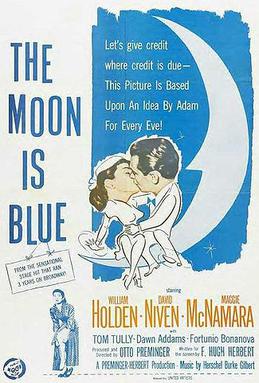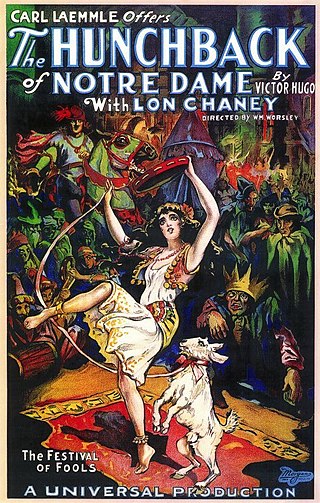Related Research Articles

The Motion Picture Production Code was a set of industry guidelines for the self-censorship of content that was applied to most motion pictures released by major studios in the United States from 1934 to 1968. It is also popularly known as the Hays Code, after Will H. Hays, president of the Motion Picture Producers and Distributors of America (MPPDA) from 1922 to 1945. Under Hays's leadership, the MPPDA, later the Motion Picture Association of America (MPAA) and the Motion Picture Association (MPA), adopted the Production Code in 1930 and began rigidly enforcing it in 1934. The Production Code spelled out acceptable and unacceptable content for motion pictures produced for a public audience in the United States.

The Moon Is Blue is a 1953 American romantic comedy film produced and directed by Otto Preminger and starring William Holden, David Niven, and Maggie McNamara. Written by F. Hugh Herbert and based on his 1951 play of the same title, the film is about a young woman who meets an architect on the observation deck of the Empire State Building and quickly turns his life upside down. Herbert's play had also been a huge success in Germany, and Preminger decided to simultaneously film in English and German, using the same sets but different casts. The German-language film version is Die Jungfrau auf dem Dach.

William Harrison Hays Sr. was an American politician, and member of the Republican Party. As chairman of the Republican National Committee from 1918 to 1921, Hays managed the successful 1920 presidential campaign of Warren G. Harding. Harding then appointed Hays to his cabinet as his first Postmaster General. He resigned from the cabinet in 1922 to become the first chairman of the Motion Picture Producers and Distributors of America. As chairman, Hays oversaw the promulgation of the Motion Picture Production Code, which spelled out a set of moral guidelines for the self-censorship of content in American cinema.
The National Legion of Decency, also known as the Catholic Legion of Decency, was a Catholic group founded in 1934 by Archbishop of Cincinnati, John T. McNicholas, as an organization dedicated to identifying objectionable content in motion pictures on behalf of Catholic audiences. Members were asked to pledge to patronize only those motion pictures which did not "offend decency and Christian morality". The concept soon gained support from other churches.

The Hunchback of Notre Dame is a 1923 American drama film starring Lon Chaney, directed by Wallace Worsley, and produced by Carl Laemmle and Irving Thalberg. The supporting cast includes Patsy Ruth Miller, Norman Kerry, Nigel de Brulier, and Brandon Hurst. Distributed by Universal Pictures, the film was the studio's "Super Jewel" of 1923 and was their most successful silent film, grossing $3.5 million. The film premiered on September 2, 1923 at the Astor Theatre in New York, New York, then went into release on September 6.
Joseph Burstyn, Inc. v. Wilson, 343 U.S. 495 (1952), also referred to as the Miracle Decision, was a landmark decision by the United States Supreme Court that largely marked the decline of motion picture censorship in the United States. It determined that provisions of the New York Education Law that had allowed a censor to forbid the commercial showing of a motion picture film that the censor deemed "sacrilegious" were a "restraint on freedom of speech" and thereby a violation of the First Amendment.

Film censorship is the censorship of motion pictures, either through the excising of certain frames or scenes, or outright banning of films in their entirety. Film censorship typically occurs as a result of political or moral objections to a film's content; controversial content subject to censorship include the depiction of graphic violence, sexual situations, or racial themes. Censorship standards vary widely by country, and can vary within an individual country over time.

The Penalty is an American psychological thriller crime film starring Lon Chaney and originally released in 1920 by Goldwyn Pictures. The movie was directed by Wallace Worsley, and written by Philip Lonergan and Charles Kenyon, based upon the pulp novel by Gouverneur Morris. The supporting cast includes Charles Clary, Doris Pawn, Jim Mason, and Claire Adams. The copyright for the film was owned by Gouverneur Morris, who wrote the novel on which the film was based. The budget for the film was $88,868.00. Portions of the film were shot in San Francisco.

A Blind Bargain is a 1922 American silent horror film starring Lon Chaney and Raymond McKee, released through Goldwyn Pictures. The film was directed by Wallace Worsley and is based on Barry Pain's 1897 novel The Octave of Claudius. Lon Chaney played a dual role in the film, as both Dr. Lamb and "the Ape Man", one of Chaney's few "true horror films". The claim that Wallace Beery appeared as an ape-man uncredited has never been proven, but does persist in many sources.
Joseph Ignatius Breen was an American film censor with the Motion Picture Producers and Distributors of America who applied the Hays Code to film production.
The Stronger Mind is a 1915 American silent drama film directed by Joe De Grasse and featuring Lon Chaney, Murdock MacQuarrie and Pauline Bush. Chaney did not routinely work for the United production unit at Universal, and was obviously sent over as a one-time loan-out for this production. It is now considered to be a lost film. A still exists showing MacQuarrie and Chaney as the two bank robbers.
Joseph Burstyn was a Polish-American film distributor who specialized in the commercial release of foreign-language and American independent film productions.
Freedman v. Maryland, 380 U.S. 51 (1965), was a United States Supreme Court case that ended government-operated rating boards with a decision that a rating board could only approve a film and had no power to ban a film. The ruling also concluded that a rating board must either approve a film within a reasonable time, or go to court to stop a film from being shown in theatres. Other court cases determined that television stations are federally licensed, so local rating boards have no jurisdiction over films shown on television. When the movie industry set up its own rating system—the Motion Picture Association of America—most state and local boards ceased operating.

The Ace of Hearts is a 1921 American crime drama film produced and directed by Wallace Worsley. The screenplay by Ruth Wightman is based on Gouverneur Morris's story The Purple Flask, which was serialized in two parts in Cosmopolitan magazine in 1917. The film stars Leatrice Joy, John Bowers, Raymond Hatton and Lon Chaney. One unique feature of this film is that the main title of the movie isn't written on the screen; rather an Ace of Hearts card is shown in its place instead.

Voices of the City is a 1921 American silent crime drama film starring Leatrice Joy and Lon Chaney that was directed by Wallace Worsley, based on the Leroy Scott novel The Night Rose. The film took more than 9 months to be released due to a controversy over the proposed title and the film's abundance of gunplay. The film was retitled Voices of the City and was only released in December 1921, although it had been completed in early March. The film is still listed under The Night Rose in some reference sources.

Tomorrow's Children, also known as The Unborn in the United Kingdom, is a 1934 American drama film written by Wallace Thurman and directed by Crane Wilbur. The film partially criticizes the eugenic policies in practice in the United States during those times. The film was widely deemed "immoral" and "tending to incite crime".

Film censorship in the United States was a frequent feature of the industry almost from the beginning of the U.S. motion picture industry until the end of strong self-regulation in 1966. Court rulings in the 1950s and 1960s severely constrained government censorship, though statewide regulation lasted until at least the 1980s.
The Virginia State Board of Censors was a government agency formed on August 1, 1922 for the purpose of reviewing and licensing films for approval to be screened in the state of Virginia. During the agency's existence its members examined over 52,000 films, over 2,000 of which required edits before approval was given; and another 157 films were rejected entirely, of which only 38 won subsequent approval. The board disbanded in 1968 following a series of U.S. Supreme Court rulings which overturned censorship statutes across the country.

Ravished Armenia, also known as Auction of Souls, is a 1919 American silent film based on the autobiographical book Ravished Armenia by Arshaluys (Aurora) Mardiganian, who also played the lead role in the film. The film, which depicts the 1915 Armenian genocide by the Ottoman Empire from the point of view of Armenian survivor Mardiganian, who plays herself in the film, survives in an incomplete form.
Times Film Corporation v. City of Chicago, or Times v. City of Chicago is the name of two cases decided by the U.S. Supreme Court in 1957 and 1961. Both involved the issue of limits on freedom of expression in connection with motion pictures. In both cases the court affirmed the right of local governments to engage in some form of censorship.
References
- ↑ Kehr, Dave. "A Wanton Woman's Ways Revealed, 71 Years Later", New York Times 9 Jan. 2005.
- 1 2 Anderson, Mark (2007). "Tempting Fate: Clara Smith Hamon, or, the Secretary as Producer". In Lewis, Jon; Smoodin, Eric (eds.). Looking Past the Screen: Case Studies in American Film History and Method. Duke University Press. p. 148, note 62. ISBN 978-0-8223-9013-8.
- ↑ "Goldwyn Demands Court See Feature: Object to Censors Throwing Out The Night Rose". Variety. New York City: Variety, Inc. 1921-11-04. p. 1. Retrieved 2017-06-10.
- ↑ "Appeal from Censor's Decision Denied". Variety. New York City: Variety, Inc. 1921-11-25. p. 1. Retrieved 2017-06-10.
- ↑ Wittern-Keller, Laura (2008). Freedom of the Screen. University Press of Kentucky. ISBN 978-0-8131-2451-3.
- ↑ Andress, Richard. "Film Censorship in New York State". New York State Archives . Archived from the original on 17 May 2008. Retrieved 27 February 2015.